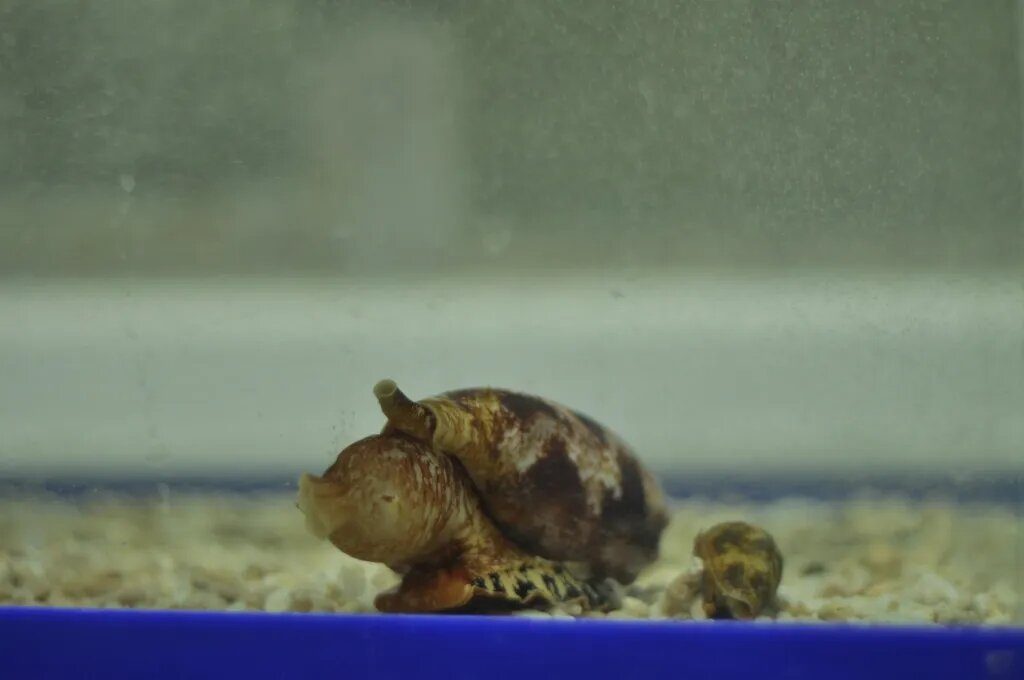Written by UP Media and Public Relations Office

Who could imagine that something as small as cone snails, popular among shell collectors and tropical-themed jewelry makers for their intricately colored shells, is the key to a substantial medical breakthrough waiting to be unlocked?
Perhaps it is fitting that a young Filipino scientist, Iris Bea Ramiro, is next in line to reveal the biomedical potentials in these venomous sea snails commonly found in Philippine reefs and waters. Ramiro, a UP College of Science alumna, a researcher at the UP Marine Science Institute (MSI), and now a Ph.D. student and researcher at the University of Copenhagen Department of Biomedical Sciences in Denmark, is following in the footsteps of other internationally renowned Filipino scientists and UP alumni.
Read the full paper here.

From toxin to medicine

Over the past decades, scientists have reported that the toxins produced by cone snails (family Conidae) contain a unique component called conotoxins, which generate new kinds of painkillers and drugs to treat disease. But scientists have barely scratched the surface when it comes to exploring the biomedical potentials of the planet’s marine life, and the research continues.
Ramiro and her team conducted their study off the coast of Sogod, Cebu Province. They observed a deep water species of fish-hunting cone snails of the Asprella clade using a hunting method known as “ambush-and-assess.” This method involves the snail stinging its prey with its venom and waiting between one to three hours for its target to become sluggish and unable to counterattack, after which the snail moves in to finish the job. The method differed from the more widespread “taser-and-tether” technique, where cone snails use toxins to electrocute their prey rapidly; and the “net-hunting” strategy, where cone snails release venom into the water to knock the target insensible. The hours-long wait between the first strike to having a meal in the “ambush-and-assess” method struck Ramiro as unusual, leading her to investigate further by focusing on two species of Asprella cone snails, the Conus rolani and Conus neocostatus.
“No one in our lab was working on it at that time,” she said in the press release published by the University of Utah press. “I was just looking to identify any small peptide (chain of amino acids) from the venom of C. rolani that had unusual or interesting activity in mice.”
She discovered that the toxins Asprella cone snails use contain a peptide called Consomatin Ro1, which closely resembles the neuropeptide hormone somatostatin. Humans naturally produce somatostatin, which inhibits growth hormone secretion and cell production. It may be a possible treatment for cancer, diabetes, pain and inflammation, and endocrine disorders. Consomatin Ro1 resembles a drug analog or copy of somatostatin called octreotide, currently available under the brand name Sandostatin.

The critical difference is that Consomatin Ro1 is slow acting. Unlike human-produced somatostatin, which has only a half-life of one to three minutes, and octreotide, which has a half-life of 90 minutes after intravenous infusion, Consomatin Ro1 has a much longer half-life of more than 158 hours or more than six and a half days. ( During a test involving Consomatin Ro1 in a plasma stability assay, somatostatin’s half-life was five and a half hours.) The peptide from Asprella cone snails can stick around much longer than somatostatin. On top of that, Consomatin Ro1 also functions the same way as somatostatin does. The human body has five somatostatin receptor subtypes that this peptide binds to activate its powers of hormone and cell growth inhibition. So far, Consomatin Ro1 appears to bind strongly to somatostatin receptor subtypes 1and 4, making it an effective compound.
“It has the potential to become a lead for pain treatment because two of those human receptors that the Consomatin targets are involved in pain. So that’s what we pursued and found it works,” Ramiro told Inverse Science writer Elana Spivack.
Sea snail-based neuropharmacology
Ramiro’s research builds upon the ever-growing field of neuropharmacology revolving around predatory sea snails, which scientists have described as “medical marvels”.
The key figures in this field include: University of Utah Distinguished Professor Dr. Baldomero M. Olivera, who earned his BS Chemistry degree from UP and was given an honorary Doctor of Science degree by his alma mater in 2008 in recognition of his accomplishments in marine drug research; and, Dr. Gisela P. Concepcion, UP MSI Professor Emeritus and former UP Vice President for Academic Affairs. Dr. Concepcion, who led the UP MSI Marine Natural Products (MNP) Laboratory until her retirement, continued the research collaboration with Dr. Olivera, which started with her mentor, National Scientist, and UP MSI Professor Emeritus Lourdes J. Cruz, in the 1970s.
Dr. Concepcion served as Ramiro’s MS thesis adviser. Later, while researching Asprella cone snails, Ramiro went to the University of Utah to consult with Dr. Olivera.

“For many years now, I have been building the Conoidean research capability of the UP MSI MNPLab by collaborating with Dr. Olivera,” Dr. Concepcion said in an interview with the UP MPRO. “Our research assistants and graduate students have been trained in his lab at the University of Utah, and we have succeeded in establishing critical technologies such as snail taxonomy, venom extraction, biochemical isolation, purification, characterization of peptides, peptide sequence determination, chemical synthesis and folding, and animal-, cell- and receptor-based neuroactivity testing. All of these are required to undertake snail venom research.”
The DOST’s Philippine Council for Health Research and Development has long since recognized the value of this research field for the country. It supports the UP MSI’s PharmaSeas Program, followed by the Marine Drug Discovery and Development Program. This support has enabled UP MSI scientists and researchers to publish their discoveries in international journals. Dr. Concepcion names at least four examples of UP MSI studies conducted by graduate students and research assistants she mentored on the peptides produced by various species of sea snails with potential application as painkillers.
As for Ramiro’s discovery of the compound in Asprella cone snails’ venom and its potential, Dr. Concepcion said they have already applied for an Invention Disclosure Incentive (IDI) from the Technology Transfer and Business Development Office of both UP Diliman and the UP System. Although the evaluation process takes time, both Ramiro and Dr. Concepcion noted the possibility of UP partnering with a private company to produce and market the drug.
“We can chemically synthesize sufficient peptide quantities for proof-of-concept studies in an animal pain model,” Dr. Concepcion said.
Press on and persevere
Ramiro grew up in Bohol, where anglers know how to find and catch the venomous cone snails. In an interview with the UP MPRO, she said she received encouragement and support while UP MSI’s MNP Lab was acquiring the equipment to do biochemical characterization of the peptides in the venom, which made for a bit of a slow start.

“I think UP has come a long way with new equipment and expertise helping fast-track some of our research,” she said. “I also had excellent lab mates, and we had good teamwork in the field and the lab. We supported each other with the different tasks.”
She also experienced good teamwork as a researcher at the University of Copenhagen. “We are fortunate to receive support and guidance from different research groups as we (my current lab) started experiments in this area.”
Nevertheless, the drudgework of scientific research is the same whether it is done in UP or elsewhere. “Sometimes experiments do not work. One tries the next week again,” Ramiro said philosophically. What keeps her going despite the failed experiments? “Thinking of the ‘why,’ the project’s goal, then aiming for it. Persevering through failures and having fun while doing it.”
Ramiro credits UP for equipping its students with the knowledge and fostering an environment where students are “encouraged to explore and learn from others, not just within the university but even collaborators outside UP. I think UP is well connected with other universities in the Philippines and abroad,” Ramiro noted.

And as for the young Filipino researchers and graduate students, Ramiro encourages them to press on and persevere. “Experiments may not work the first time—or the nth time—but one has to try again. Learn as much as you can from others. I learned a lot from discussions with professors, lab mates and colleagues, and our collaborators.”
Then she added: “And as I learned from my recent class, have fun!”
Fascinated by the secret biomedical powers of cone snails and other Philippine marine animals? Learn more in these three educational videos by TVUP:
Dr. Ronie Calugay of the UP Baguio Biology Department on “Conotoxins”
Dr. Gisela Concepcion on “Marine Organisms from the Philippines”
Dr. Lourdes Cruz, “From Killer Snails to Biodiversity”
Feature story by Franco Gargantiel and Celeste Llaneta, UP Media and Public Relations Office
Source: https://up.edu.ph/cone-snails-from-lethal-killers-to-medical-marvels/
